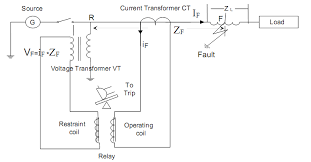The below shows the balanced beam type definite distance relay. As the industry continued to learn.

Transmission Lines Distance Relay Basics And Tutorials Transmission Lines Design And Electrical Engineering Hub
Free of the inherent inertia of electromechanical devices these distance relays operated very fast.

. Manufacturers follow their own design and manufacturing practices to provide products that are competitive and that follow industry standards. A distance element operates when. These designs used analog circuits with semiconductors.
To read real time voltage and current signals and to generate Zone 2. There is one voltage element from potential transformer and a current element fed from current transformer of the system. 156 The amount of the expansion depends on the element design but is generally proportional to the source impedance of the system Ref 15.
Distance relay designs based on filtering and coincidence timing by using analogue circuits with semiconductors. A distance relay measures the voltage V and current I at one end of the line. Distance relays are actually double actuating quantity relays with one coil energized by voltage and the other coil by current.
Discusses relay testing using conceptsline distance relay elements as examples. The relay operates only when the VI ratio falls below a predetermined value or set value. Distance relays to prevent unwanted distance relay element operation during power swings.
Reverse Ground Faults and Ground Distance Elements The operating quantities for ground distance elements include residual current 3I0. DISTANCE RELAYS 65 any value of impedance that is within the Z1 circle will cause all three impedance units to operate. Simple overcurrent protection lacks this property and its reach is highly dependent on the source impedance.
The main purpose of the PSB function is to differentiate between faults and power swings and block distance or other relay elements from operating during a power swing. Distance elements are used in line protection schemes for their definite reach. POL 90 2 For decades various relay technologies have derived and compared the operating and polarizing signals differently.
Distance element regardless operation of a particular relay design. Supervise Distance Elements Directional elements add security to all distance elements. This is set to protect 100 of the line length AB plus at least 50 of the numerical three stepped.
This is set to protect between 80 of the line length AB. Principles and Characteristics of Distance Protection. Three stepped Distance-relay protection zones Zone 1.
We want a distance element to respond to faults short of a predetermined reach point and restrain for faults beyond that reach point. Decades of distance element design enhancements the industry arrived at a version of ts that is more distance elemen dependable and secure than in the early days of distance protection but only if the fault current sources behave like synchronous generators. However faults that occur.
Department of Energys Office of Scientific and Technical Information. Of three stepped distance relay. These relays may sometimes be set based in percentages of the line impedances for example a typical setting for zone 1 is 80 of the impedance of the line in order to not reach the remote end the zone 2 can.
Relays can meet the requirements but re quire complex and expensive communications links. OLTAGES AND The paper analyzes key parts of todays distance elements. Construction of Definite Distance Relay.
The operation of Z1 and the directional unit will trip a breaker directly in a very short time which we shall call T1Whenever Z3 and the directional unit operate the timing unit is ener gized. Designers introduced distance relay designs based on filtering and coincidence timing. Long reaching forward set ground distance elements can pick up for a close-in reverse ground fault on.
The constructional design of this type of relay can be a balanced beam-type or induction disc type that operates instantaneously for the fault up to a predetermined distance from the relay. If a fault occurs at F close to C on the parallel line CD the directional unit R D at A will restrain due to current I F1At the same time the impedance unit is prevented from operating by the inhibiting output of unit R DIf this control is not provided the under impedance element could operate prior to circuit breaker C opening. Distance relays are one of the most important protection elements in a transmission line.
An electromechanical distance may use a replica scheme. Uniquely a distance relay measures th e apparent impedance derived. The characteristics and specifications are public and published in data sheets or instruction manuals.
In a 2-terminal system the remote infeed has the effect of increasing the apparent fault. The deflecting torque is produced by secondary current of CT and restoring torque is produced by voltage of potential transformer. The working principle of distance relay or impedance relay is very simple.
The current element produces a positive or pick-up torque while the voltage element produces a negative or reset torque. Reversal of current through the relay from I F1. As the industry continued to learn about electromagnetic.
A definite reach is highly desired in distance elements. In actual fact most distance relay protections are applied to terminal systems. B ImZ ReZ Z R Reach Point Z aZ R I V Directional Supervision cSpring Pivot R I N 1 N 2V Trip Contact Fig.
Free of the inherent inertia of electromechanical devices these distance relays operated very fast.

Distance Relay Types Working Characteristics Its Applications

Distance Relay Working Principle Characteristics Its Classification

Principles And Characteristics Of Distance Protection

Distance Relay Or Impedance Relay Working Principle Types Electrical4u

Distance 21 Protection Electric Power Measurement And Control Systems Automation Textbook
Stepped Distance Protection Characteristics For The Relay R1 Download Scientific Diagram

Distance Relay Or Impedance Relay Working Principle Types Electrical4u

Transmission Lines Distance Relay Basics And Tutorials Transmission Lines Design And Electrical Engineering Hub
0 comments
Post a Comment